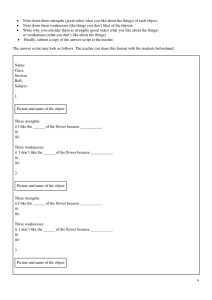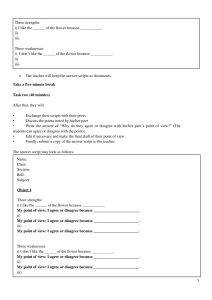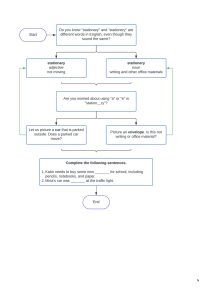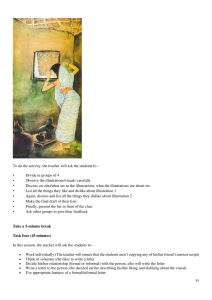Class Six/ Sixth grade children’s assessment new subject
6.1 Ability to communicate with relevance to a given context
6.2 Ability to use appropriate vocabulary/ expression (in form of synonyms, antonyms,
phrases, etc.) in accordance with the context
6.3 Ability to appreciate democratic atmosphere in communication, and participate
accordingly
6.4 Ability to comprehend and connect to a literary text using contextual clues
Day 1 (90 minutes/two consecutive classes)
Task one (45 minutes)
Firstly, in this session, students note down individually at least three good things (strengths) and at least three weaknesses (or things that they didn’t like) about the given objects (the teacher will select some objects) like a pen, marker, water bottle, blackboard, whiteboard, flower, fruit, etc). The teacher will tell and write down the instructions on the board. S/he may help them to understand the activity but not the answers)
To do the activity, the teacher will ask the students to –
• Observe three/four objects carefully
• Write down the name of the objects (if possible, draw them)
• Note down three strengths (good sides/ what you like about the things) of each object.
• Note down three weaknesses (the things you don’t like) of the objects.
• Write why you consider them as strengths (good sides/ what you like about the things)
or weaknesses (what you don’t like about the things)
• Finally, submit a copy of the answer script to the teacher.
The answer script may look as follows. The teacher can share this format with the students beforehand:

Name:
Class:
Section:
Roll:
Subject:
Picture and name of the object
Three strengths:
i) I like the ______ of the flower because ___________.
ii)
iii)
Three weaknesses:
i) I don’t like the ______ of the flower because ___________.
ii)
iii)
2.
Picture and name of the object
Three strengths:
i) I like the ______ of the flower because ___________.
ii)
iii)
Three weaknesses:
i) I don’t like the ______ of the flower because ___________.
ii)
iii)
3.
Picture and name of the object Three strengths:
i) I like the ______ of the flower because ___________.
ii)
iii)
Three weaknesses:
i) I don’t like the ______ of the flower because ___________.
ii)
iii)
• The teacher will keep the answer scripts as documents.
Take a five-minute break
Task two (40 minutes)
After that, they will
• Exchange their scripts with their peers
• Discuss the points noted by his/her peer
• Write the answer of “Why do they agree or disagree with his/her peer’s point of view?” (The
students can agree or disagree with the points)
• Edit if necessary and make the final draft of their point of view
• Finally, submit a copy of the answer script to the teacher.
The answer script may look as follows.

Name:
Class:
Section:
Roll:
Subject:
Object 1
Three strengths:
i) I like the ______ of the flower because ___________.
My point of view: I agree or disagree because _______________________.
ii)
My point of view: I agree or disagree because _______________________.
iii)
My point of view: I agree or disagree because _______________________.
Three weaknesses:
i) I don’t like the ______ of the flower because ___________.
My point of view: I agree or disagree because _______________________.
ii)
My point of view: I agree or disagree because _______________________.
iii)
My point of view: I agree or disagree because _______________________.
The teacher will monitor the students while they work and identify the students who need guidance and help. The teacher will identify the students who need limited/ full guidance and help accordingly. The teacher will keep a record of those students to assess them.
6.2.2: ability to use appropriate vocabulary/ expression (in the form of synonyms, antonyms, phrases, etc.)
in accordance with the context.
Day 2 (90 minutes/two consecutive classes)
Task Three (40 minutes)
In this session, students will be exposed to two illustrations/visuals and describe their feelings about the visuals. Specific focus here is on the formal and informal written communication.


To do the activity, the teacher will ask the students to –
• Divide in groups of 4
• Observe the illustrations/visuals carefully
• Discuss on who/what are in the illustrations, what the illustrations are about etc.
• List all the things they like and dislike about illustration 1
• Again, discuss and list all the things they dislike about illustration 2
• Make the final draft of their lists
• Finally, present the list in front of the class
• Ask other groups to give their feedback
Take a 5-minute break
Task four (45 minutes)
In this session, the teacher will ask the students to-
• Work individually (The teacher will ensure that the students aren’t copying any of his/her friend’s answer script)
• Think of someone s/he likes to write a letter
• Decide his/her relationship (formal or informal) with the person, s/he will write the letter
• Write a letter to the person s/he decided earlier describing his/her liking and disliking about the visuals
• Use appropriate features of a formal/informal letter
• Write the final draft if needed
• Finally, submit the final copy
The teacher will keep the copy as a record.
06.01.03 Students interact using appropriate ways of greetings, addressing, refusal, and closing remarks according to the specific culture and context
06.03.01 Students practice democratic skills in different situations
06.03.02 Students encourage a democratic attitude in different situations.
Day 3 (180 minutes/four consecutive classes)
Task five (90 minutes)
In this session, the teacher will ask the students to-
• Work in groups of 4
• Look at the illustration 2 carefully
• Now, imagine who she is, what she is doing, where she is and what she is watching or looking for through the
window.
• Imagine 2 or 3 characters if you want to write a storyline using the illustration and give their names
• Decide their names
• Think what will be their relationship
• Think some dialogues that the imaginative characters will tell to each other
• Write who are telling the dialogues to whom
• Write why the characters are telling the dialogues
• Write all the imaginative dialogues with who are telling to whom
• Arrange the dialogues sequentially
• Make necessary edits
• Finally, present/ act out the conversations in front of the class
Take a 5-minute break
Task six (80 minutes)
In this session, the teacher will use illustration 2 and ask the students to-
• Work individually
• Observe the illustration 2 carefully
• Reflect on the character, setting and theme of the illustration they have discussed in session 5
• Read the dialogues they have written in session 5 again
• Imagine a story line with these characters, theme, setting and dialogues
• Come up with some new characters, theme and settings if those are needed to complete the storyline
• Do the necessary edits
• Submit the final copy of their story line to the teacher.
The teacher will ensure that the students cannot copy each other. S/he will keep the copies for assessing the students. The focus of the activity is to check the literary features of the story line.
06.04.02 Students produce texts following the features of the literary texts based on their experience/imagination
06.02.02 Students use different linguistic features according to the context in producing texts
The teacher will monitor the students while they work and identify the students who need guidance and help. The teacher will identify the students who need limited/ full guidance, and help accordingly. The teacher will keep a record of those students to assess them

